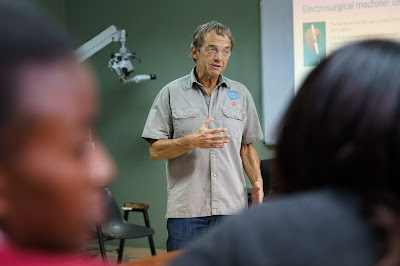Dr Alice Holmes and Dr Arla Gamper travelled to Gondar in Northern Ethiopia in the summer of 2016. There they assisted with data collection for a novel study concerning diabetes. Here follows an account of their time there.
Gondar University Hospital is situated in the Amhara region
in the North of Ethiopia. It serves a population of 5 million, 90% of whom live
rurally with poor access to the central hospital. There are 9 health centres in
rural settings in the region, and much of the success of the work done by Sir
Eldryd Parry and colleagues over the last 15 years is evidenced in these
centres, where patients’ health care needs are being met closer to their home.
In our first week we travelled to Aykel health centre, 65km
outside Gondar, where we met a 36-year-old male farmer, recently diagnosed with
diabetes. If this had been 10 years ago, he would have had to travel a full day
by foot to see a healthcare provider. Now, he is able to receive medical care for
his diabetes within one hour’s walk of his home. This is one example of the
major advances that the chronic disease programme in Ethiopia has made.
THET has been supporting the chronic disease programme for
20 years in Ethiopia to improve care of patients with epilepsy, diabetes, high
blood pressure and chronic lung disease. The programme has contributed significantly
to the strengthening of chronic disease care in rural Ethiopia. Patients with
type one diabetes, that means those requiring insulin from the point of
diagnosis, have different characteristics to those who are diagnosed with type
one diabetes in the UK. The purpose of our work with the team in Gondar was to
assist with a study looking at the reasons for this difference.
Previous studies in Ethiopia have described new diabetics as
presenting later in life than in the West, which closely resembles the
previously described malnutrition related diabetes[i].
The current study hypothesises that this alternative presentation is related to
early malnutrition and possibly chronic illnesses in childhood[ii].
We assisted with data collection from diabetics and age and sex matched
controls. We hope that the study will help to understand in more detail the
nature of this disease which is seen across sub-Saharan Africa. This knowledge
could contribute to better treatment options and prevention.
Treating an Ethiopian rural farmer, who may have had no
formal education, to manage his blood sugar with insulin is no mean feat. Prior
to the chronic disease programme, this patient would have had to travel many
hours to Gondar, to collect insulin, often requiring him to take time off work,
thus losing essential income for himself and his family. Educating such
patients on the importance of good blood sugar control, managing low blood
sugar, and preventing the complications of diabetes has been a remarkable
success. The dedication and perseverance of Dr Shitaye and her team has enabled
these patients to have an understanding of their disease, appropriate local
follow up, and a reliable supply of free insulin. The creativity of the
patients who have to keep their 3 monthly supply of insulin cool is admirable –
they store their insulin in bags of sand, below ground level, ensuring its
safety and efficacy even after some weeks in a hot climate.
During our time on the medical ward in Gondar University
Hospital we observed the care of patients presenting with communicable and
non-communicable diseases. Treating patients with diabetic complications, such
as diabetic foot ulcer, highlights some of the challenges of providing
effective health care in this setting. On the ward we met a 24-year-old farmer
with a diabetic foot ulcer and underlying bone infection. We observed the
difficulties the doctors had in managing his blood sugars on the ward. Without
basic equipment, such as that to measure blood sugar, doctors are not able to
provide optimal care. We observed limitations to acquiring equipment, reagents
and medications on numerous occasions, which is a major limiting factor to
providing healthcare in Gondar.
People’s understanding of disease and its cause in this area
poses another challenge to providing care. Many patients wait for some time
before seeking medical advice for their symptoms; consulting a traditional
healer in the first instance, who is often more accessible, before presenting
to the hospital. This combined with the fact that the vast majority of the
population live rurally and many hours from the nearest health centre means
that patients come late and with significant complications of their illness. Challenging
health beliefs and educating patients about their medical condition is
difficult in any setting, but especially here. The introduction of
community-based Health Extension Workers over the past few years has
contributed significantly to the reduction in maternal mortality, and increased
life expectancy, and it is hoped that the integration of these professionals
into communities will add to and enable better disease management and health
literacy.
[i] Alemu S, Dessie A, Seid E et al. Insulin-requiring diabetes in rural Ethiopia: should we reopen the case for malnutrition-related diabetes? Diabetologia (2009) 52:1842–1845
[ii] Fedaku S, Yigzaw M, Alemu S et al. Insulin-requiring diabetes in Ethiopia: associations with poverty, early undernutrition and anthropometric disproportion. European Journal of Clinical Nutrition (2010) 64:1192-1198.




